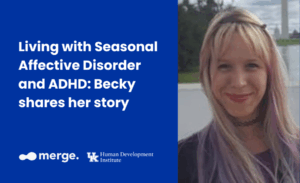Opportunities to make life more inclusive are everywhere – even something as simple as the language we use can have huge implications for accessibility.
One of the most powerful tools in creating accessible writing is plain language. And thanks to a recent request from the Association of University Centers on Disability (AUCD), HDI was able to do some very visible work in promoting plain language.
“We have, in the past, contacted with AUCD to do various plain language initiatives,” Patti Singleton, Division Director for Professional Learning, said. “They had a definition of what equity and inclusion was, and why it was important. However, the statement used language that was hard to understand.”
AUCD felt it needed to be more inclusive in how it defined inclusivity – and they chose HDI to help them fix it.
“AUCD came to us and said ‘This is what we currently have, would you like to revise it and write it into plain language,’” she said. “We said of course.”
Singleton gathered a team that included ISAW Principal Investigator Bev Harp, Medical Outreach Director Stephanie Meredith, DEI Director Dr. Nicholas Wright and HDI Staff Member Chelsea Bocard. She also worked with Liz Weintraub, who is the Senior Advocacy Specialist at AUCD and a longtime advocate for plain language.
Plain Language is a universal design strategy that seeks to make sure anyone can understand the language used in documents. There is even a law in place mandating that federal organizations use plain language when communicating with the public.
“We really want to make sure that all information we provide is written clearly, concisely and is well-organized,” Singleton said. “It really comes down to using common words…that everyone would be able to understand.”
It also means keeping away from jargon or acronyms that may be unfamiliar to outside sources, and ensuring that information is well organized and easy to understand. It can be vital to people with certain disabilities to make sure information is clearly conveyed.
“Research shows that people with intellectual disabilities often face discrimination and bias when trying to reach their goals in life. However, it can be hard to recognize what’s happening in the moment. I had that experience one time when my son with Down Syndrome was refused service at an urgent care facility,” Meredith said. “That way they can advocate to be treated fairly and to get any support they might need.”
This, Wright said, is a subtle but important part of diversity and inclusion.
“Many people view diversity in the apparent view, but I believe in focusing on diversity more holistically,” he said. “Diversity is having individuals of various experiences, perspectives, identities, and abilities. Diversity involves having identities represented, but inclusion involves engaging these diverse identities and ensuring these individuals are fully included. Having our commitment to diversity, equity and inclusion in plain language is equity in action, and focuses on access by removing barriers.”
Plain language isn’t just important for accommodating people with disabilities, it can help everyone. Singleton noted that she always prefers plain language documents simply because as a mom who works full-time, she’s busy. Plain language is easier and less time-consuming to read.
And as a longtime partner for AUCD, Singleton thinks it’s great to both help out and to see an organization that is above HDI is embracing a cause that HDI has championed. “They value the work we do,” she said. “They see us as a leader. I love that they continue to rely on us for that information.”
This article represents the opinions of the author and interviewee, not that of the University of Kentucky.



